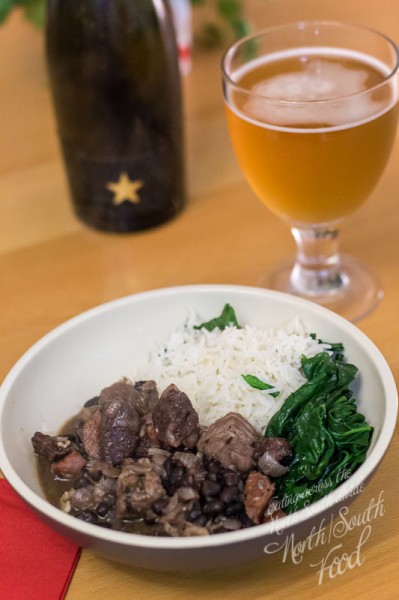
We’ve written before on more than one occasion of our shared love for all things pulse and porcine. Pretty much every pork-eating culture in the world has at least one melt-in-the mouth classic which taps into both of these elements, exploiting the extraordinary harmony and symbiosis of flavour and texture which comes from such comfort food. These are truly made for each other, and it’s a massive favourite here with us at North/South Food.
Inspired in part by a great holiday to Languedoc (and armed with a few goodies on my return) I decided to make a semi-proper cassoulet as a way of warding off the rather autumnal weather which has blighted the north of England since coming home. Not a proper proper cassoulet (with all the regional rivalries that seems to stoke up) but my own interpretation. After all, it’s a genuine classic, and something I’ve never cooked before, so it was well worth having a go at…
I used my well-thumbed copy of Elisabeth Luard’s ‘Classic French Cooking as reference: her recipe for ‘Cassoulet de Castelnaudary’ seems pretty authentic. I deviated on a few occasions, perhaps most heretically by using rabbit rather than duck or goose. You see, I’ve had a bunny in the freezer for a few months, and coming home with a lovely artisanal French sausage, I thought something casserole-y would make for a perfect combination. After a bit of reading I warmed to the idea of cassoulet.
First things first, I had to make the rabbit confit. After a good defrosting I jointed the bunny… legs off and the body / saddle in three. I had some goosefat lurking in the fridge in a kilner jar (really not sure how long it was since I last cooked a goose but I decided to take the risk) and I had a tin of store-bought stuff as well. Tip: buy reduced-price tins of goose fat from supermarkets in the weeks after Christmas. It lasts for ever, and I’m sure you know just how good roast potatoes & Yorkshire puddings are, made with real goose fat.
I melted the fat down in a saucepan, then poured them over the layered rabbit joints in a stoneware pot. I’d also sprinkled salt over the meat (using wonderful fleur de sel from the Camargue), chucked a few peppercorns into the pot, and added a couple of bay leaves. Once the meat was covered by the warm, clear goose fat, it went straight into a pre-heated gas oven at the lowest setting, covered by tinfoil, and I left it overnight.
Next day a delicate aroma greeted me when I opened the kitchen door: inside the oven the meat had blanched and warmed through. very pretty looking too. I took out the legs, ate one of the other bits for breakfast on toast (chef’s perk!) and put the rest in a kilner jar, carefully covering with the fat. That was the rabbit sorted, now for the rest.
A quick trip to Stansfield’s in the market secured some belly pork (I got Paul to remove the skin for me) and some lean escalopes. I decide not to buy some fresh sausages, determined to subvert tradition and use the dried Aveyronnais saucisse instead. This is almost as heretical as using rabbit, but I thought the rich, fatty dry sausage would work well in such a slow-cooked dish.
So I diced the belly meat, and added it to the bottom of a cast iron Le Creuset (heretical decision #3… it should of course be cooked in stoneware but I didn’t have anything large enough). I opted for canned haricot beans over dried (life’s too short for soaking pulses) and added three tins of these, together with a couple of roughly chopped carrots, a bouquet garni, a red onion studded with cloves, and a head of garlic which I’d blackened quickly over a gas flame on the hob. Also in the pot went the rolled-up belly skin. Everything was covered with water, and raised to a rolling boil, before simmering for an hour or so.
After that was done I drained everything, reserving the cooking liquor carefully. I browned the rabbit joints in a heavy frying pan, then did the same with the lean pork and a couple of diced red onions & some garlic, letting them shimmer and glisten in the hot goose fat. I unfurled the pork skin on the bottom of the cast iron pot, and layered up the beans, veg and meats on top. A tin of plum tomatoes was ably accompanied by some home-grown toms, which looked as pretty as they tasted. As the ingredients stacked up I was worried by a deficit of beans to cover everything, so I added a extra tin of cannellini beans. Then I poured the cooking broth from earlier in until everything was just coated, lidded up and put it in the oven at gas mark 2 (150°C) for about two hours.
It was about then I realised that such a long cooking process was going to severely test my patience: the smell when I opened the oven was enough to make me want to gnaw my own arm off. However the next stages would mean it was some time before I could exepct to finally tuck in. After notching the oven up to 160°C the pot went back in, uncovered, to help develop a crust. This took closer to an hour as a fair amount more liquid had been drawn out of the tomatoes, but eventually there was enough of a crust for the next stage. I spooned some goose fat over the top, and broke the crust several times before adding a layer of breadcrumbs. Breaking the crust seems to be one of the defining differences between Castelnaudary and other towns in Languedoc which lay claim to cassoulet as their own. I opted to break the ‘croute’ seven times, as Larousse Gastronomique suggests this is the Castelnaudary way. Then back in the oven again to thicken up and cook for another half an hour or so. Cue more groaning stomachs – it was at this stage I cracked open some rather good anchovy-enfused Camargue olives.
We enjoyed this with a bottle of excellent Saint-Chinian red (sticking to the Languedoc theme) and some crusty white bread to soak up the juices. Dead simple, and all that was needed to really savour this dish. It tasted wonderful, and was well worth the anticipation and wait. Better still, as so many one pot meals do, it just got better over the next couple of days.
I’d give this 7/10 for adherence to tradition, but 10/10 for flavour. The sausage was excellent, adding a complexity and richness to the dish, and the rabbit was succulent and delicious. Sometimes traditions are there to be subverted! If this heralds the season to eat rich, slow-cooked one pot wonders, then I’m glad to wrap up warmer and take things slowly. Meanwhile I’ll be rationing out the goose fat from the confit for future cooking exploits… it’s a wonderful by-product of this dish. What’s good for the goose is certainly good for me…































